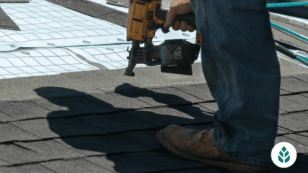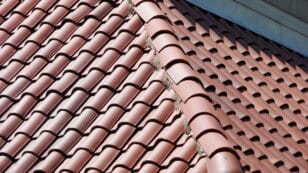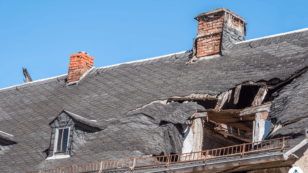
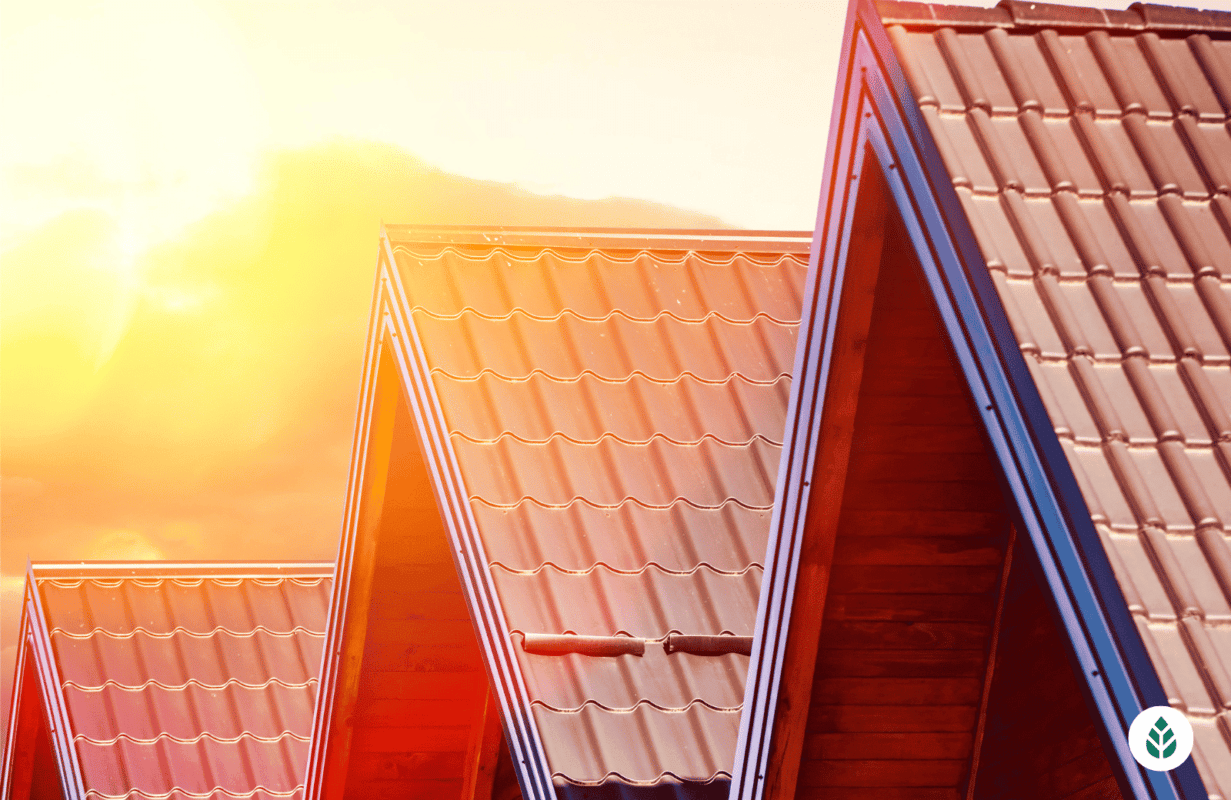
How Much Does it Cost to Install a Metal Roof 2024
Here’s what we’ll cover in this buyers guide:
- How much does metal roofing cost
- Metal roofing cost factors
- Types of metal roofing
- Benefits of metal roofing
Each product and or company featured here has been independently selected by the writer. You can learn more about our review methodology here. If you make a purchase using the links included, we may earn commission.
Metal Roofing is Increasingly Popular
Metal has become an increasingly popular roofing material. Not only does it look sleek, it’s often more durable and longer lasting compared to asphalt shingles. However, that longevity often comes with a bigger price tag. Metal roofs also come with variability, painting you roof is often an easy option.
So, how much does a metal roof cost? Installation prices range from $5,000 to $50,000, but they depends on the type of metal roofing material and style that you choose.
If you’d like to get connected with a roofing provider today for a free quote, click one of the providers below.
How Much Does Metal Roofing Cost?
The cost of a metal roof varies greatly depending on many factors including the size of your roof, roofing material cost, style and labor costs.
Calculating for the national average roof size of 1,700 square feet, causing a new metal roof will run you an average cost between $15,500 on the low end and $67,500 on the high end.
While it’s a high upfront cost compared to asphalt shingles, you’ll save more money in the long run by investing in a metal roofing system. Metal roofs are:
- Low maintenance
- Highly durable, especially in areas with extreme weather
- Long-lasting, with lifetimes anywhere from 40 to 100 years or more
- Aesthetically pleasing
These key benefits mean you’ll spend far less on future maintenance, repairs and replacement installations.
Metal Material Costs Vary by Materials
Metal roofing is a broad term encompassing all roofing materials made from metals like aluminum, steel, tin, zinc and copper. There are also several different metal roofing options and styles for homeowners to choose from, including metal shingles, slate, tiles and standing seam.
Metal roofs can often mimic the look of asphalt and wood shingles, making them a great choice for any style home.
There’s a large price range for residential roofing projects because it’s not just the cost of the material, but the labor costs you have to consider as well. Some metals may be heavier or harder to install, which will drive up the total cost for your project.
Check out the chart below for a cost comparison of the common types of metal roofs.
| Metal Roofing Material | Material Cost per Square Foot | Cost per Square (100 sq. ft.) |
Estimated Price Range for 1,700-Square-Foot Roof Installation |
| Aluminum | $3 to $9 | $300 to $900 | $9,000 to $28,000 |
| Copper | $11 to $25 | $1,200 to $2,500 | $30,000 to $70,000 |
| Corrugated metal | $3.50 to $6.50 | $350 to $650 | $10,500 to $19,500 |
| Metal slate | $5 to $12 | $500 to $1,200 | $12,000 to $25,000 |
| Standing seam | $8 to $14 | $800 to $1,400 | $24,000 to $42,000 |
| Steel shingles | $6 to $12 | $600 to $1,200 | $17,000 to $30,000 |
| Tin | $3 to $15 | $300 to $1,500 | $9,000 to $45,000 |
| Zinc | $6 to $11 | $600 to $1,100 | $15,000 to $50,000 |

Power Home

Average cost
Pros
- Positive industry reputation
- Lifetime or lengthy warranty
- 10+ years of experience
- Positive customer reviews
- Uses eco-friendly materials
- Well-trained, certified installers
- Variety of roofing styles available
Cons
- Limited variety of roofing materials
- Short or nonexistent warranty
- No financing information available
- Expensive
- Little information available on company website

Erie Home
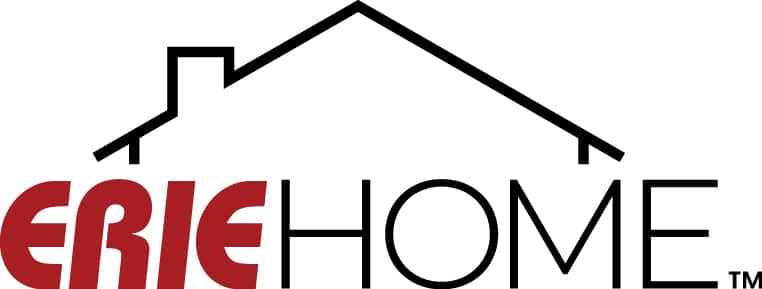
Zero Down - 18 months same as cash with minimum monthly payment
Average cost
Pros
- Lifetime or lengthy warranty
- Widespread availability
- 10+ years of experience
- Positive customer reviews
- Uses eco-friendly materials
- Financing options available
- Well-trained, certified installers
- Uses durable materials meant to last
- Variety of roofing styles available
Cons
- Limited variety of roofing materials
- Expensive

Aspen Contracting

Average cost
Pros
- Positive industry reputation
- Lifetime or lengthy warranty
- Widespread availability
- 10+ years of experience
- Positive customer reviews
- Financing options available
Cons
- Little information available on company website
Cost Factors Affecting Your Metal Roofing Installation
Metal roofing prices are typically higher compared to asphalt shingle roofs, but you’re investing in a material that will last longer and is easier to maintain.
The total cost of metal roofing will vary depending on the metal material you choose, where you live, the scope of your roofing project and the labor involved. Let’s get into the specifics.
Installing Metal Roof Labor Costs
It’s not as hard to install metal compared to many other roofing materials, as it’s surprisingly lightweight. Plus in some cases, you can install metal roofing panels right over your existing roof, even if it’s made of asphalt or wood shingles.
This means your roofer may not need as much time for installation, which could save you some money on labor costs.
However, you will be charged if your old roof — including flashing and underlayment — needs to be removed.
Permits Needed for Metal Roofs
Roofing permits typically cost between $255 and $500 on their own, although the cost is usually roped into an initial building permit if you’re building a new structure.
A roofing permit typically covers up to the first 1,000 square feet, but you may need to pay more for bigger roofs after that.
Many roofing companies will include the cost of the permit in your final roofing project estimate.
Your Location Can Affect Pricing
The cost of roofing materials and labor varies greatly from place to place. It’s more than just general cost of living differences, though.
For example, it may be more expensive to ship metal materials to your state versus another, and it may be harder to find a metal roofing contractor for the installation if metal roofs aren’t as common in your area.
Metal Roofing Material Used
As discussed throughout this article, the type of metal roofing material you choose will have a great impact on the price. Metal roofing material prices are based on the availability, durability and longevity of each material.
For example, steel and aluminum roofing options are typically cheaper, while copper roofing may cost you double.
Metal Roof Size, Slope and Pitch
It probably goes without saying, but the bigger your roof, the more your roofing project materials are going to cost. But square footage isn’t the only cost factor to consider.
A bigger, steeper roof will mean a longer and more tedious installation job for your roofers. You can expect to pay more if you have a roof with a steep slope or pitch.
Metal Roof Style will Impact Pricing
A roofing contractor will likely consider the architectural style or design of your roof when calculating the total cost of your roofing project. Similar to roof slope and pitch, the style of your roof can make a big difference in the difficulty level of the installation.
Changing Your Roof’s Underlayment
Most homeowners concentrate on the exterior roofing materials, but you’ll have to pick materials for your underlayment, too, which will be an additional cost.
The three main types of underlayment for metal roofs are felt, synthetic sheet and self-adhering membrane.
Types of Metal Roofing
We’ve mentioned the different costs associated with the various types of metal roofing materials, but there’s more than just numbers and appearance.
Each type of roofing material has varying levels of energy efficiency and longevity, and some materials may be better suited for different climates.
Below we’ll walk through some of the most common types of metal roofing materials and explain how they compare to one another.
Aluminum Roof Costs
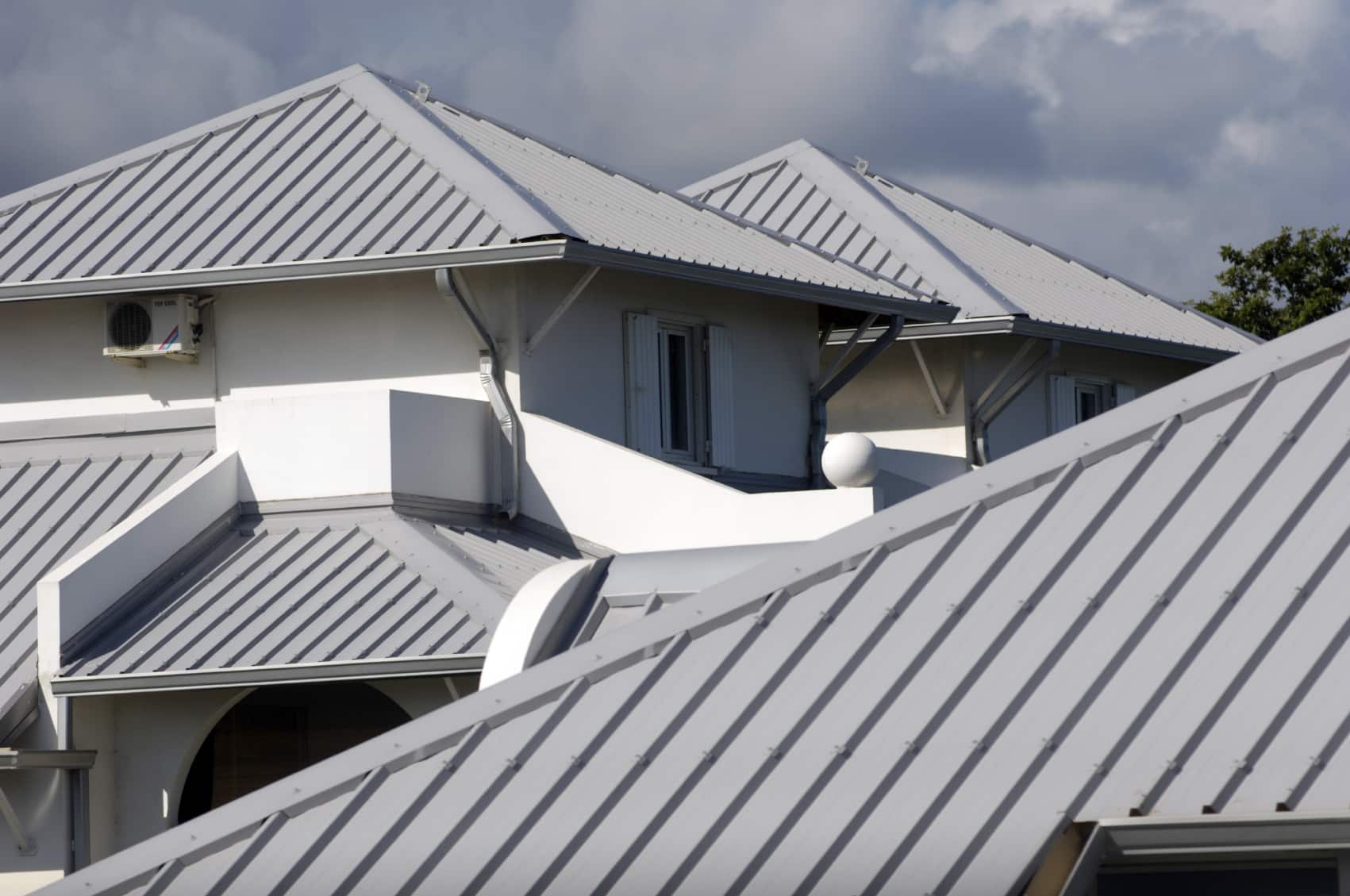
Aluminum roofing is one of the more affordable metal roofing options available, as it’s abundant, recyclable and easy to work with.
Aluminum comes in tile or shingle options and typically costs $3 to $9 per square foot with the average cost of a aluminum roof installation costing between $9,000 and $28,000.
Aluminum is more resistant to leaks compared to corrugated metal. It also holds up against fire, storms, corrosion and saltwater damage, making it a great choice for any climate, but especially homes near the ocean. Aluminum roofs can last 40 or more years on average.
The appearance of aluminum is often its biggest downside compared to other metals. Aluminum roofs also don’t age as well as other materials and are known to dent, expand and contract more than other roofing metals, which can lead to creaking sounds and general wear and tear. Aluminum can also rust over time.
Copper Roof Pricing
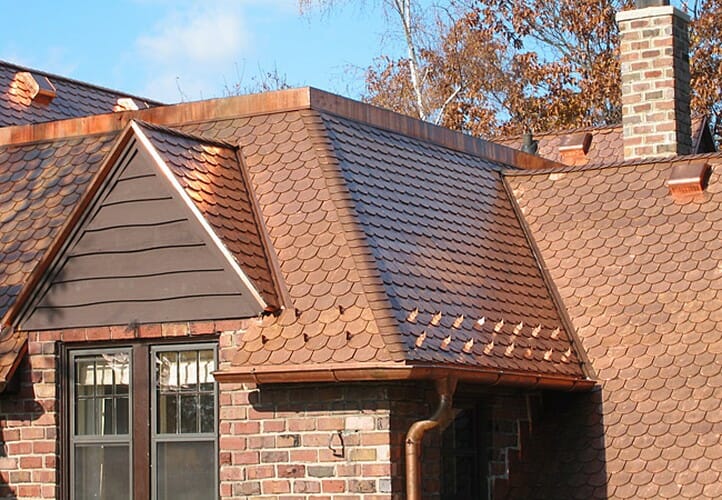
Copper is a higher-end roofing material that can last 100 years or more, so it’s no surprise it comes with a higher price tag. Copper typically costs $11 to $25 per square foot of material, with average installation costs estimated between $30,000 to $70,000.
Copper roofs are lightweight yet durable and can give a home an elegant and expensive look. It’s also one of the more sustainable metal options because of its longevity, recyclability and energy efficiency.
Copper will never corrode or rust like other metals and requires less maintenance because it develops a natural patina — a thin layer of protective covering.
Unfortunately, that patina is also what changes colors during the general oxidation process, from its beautiful gold-like color to more of a green (think of the Statue of Liberty).
You can prolong this with regular cleaning and a protective coating, but it’ll likely happen at some point.
Corrugated Metal Roof Pricing
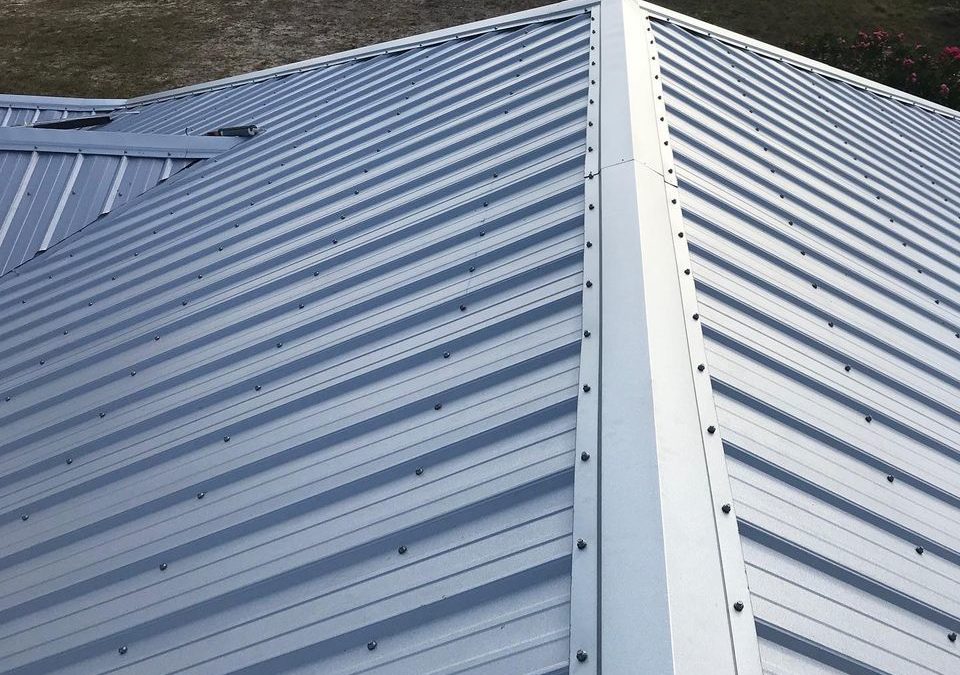
Corrugated metal roofs typically come in thin sheets that have a wavy or rippled pattern.
They’re one of the most affordable metal roofing options, comparable to asphalt shingles in price, averaging between $3.50 and $6.50 per square foot. That puts a full installation between $10,500 and $19,500.
While all metal roofs are strong, corrugated metal roofs are especially designed to hold up in harsh weather conditions and have an increased strength-to-weight ratio. These panels may be made of steel, aluminum or copper, with prices varying depending on which metal you choose.
The downside to corrugated metal panel roofs is that they’re more vulnerable to leaks and rust.
Metal Slate or Stone Coated Roof Costs
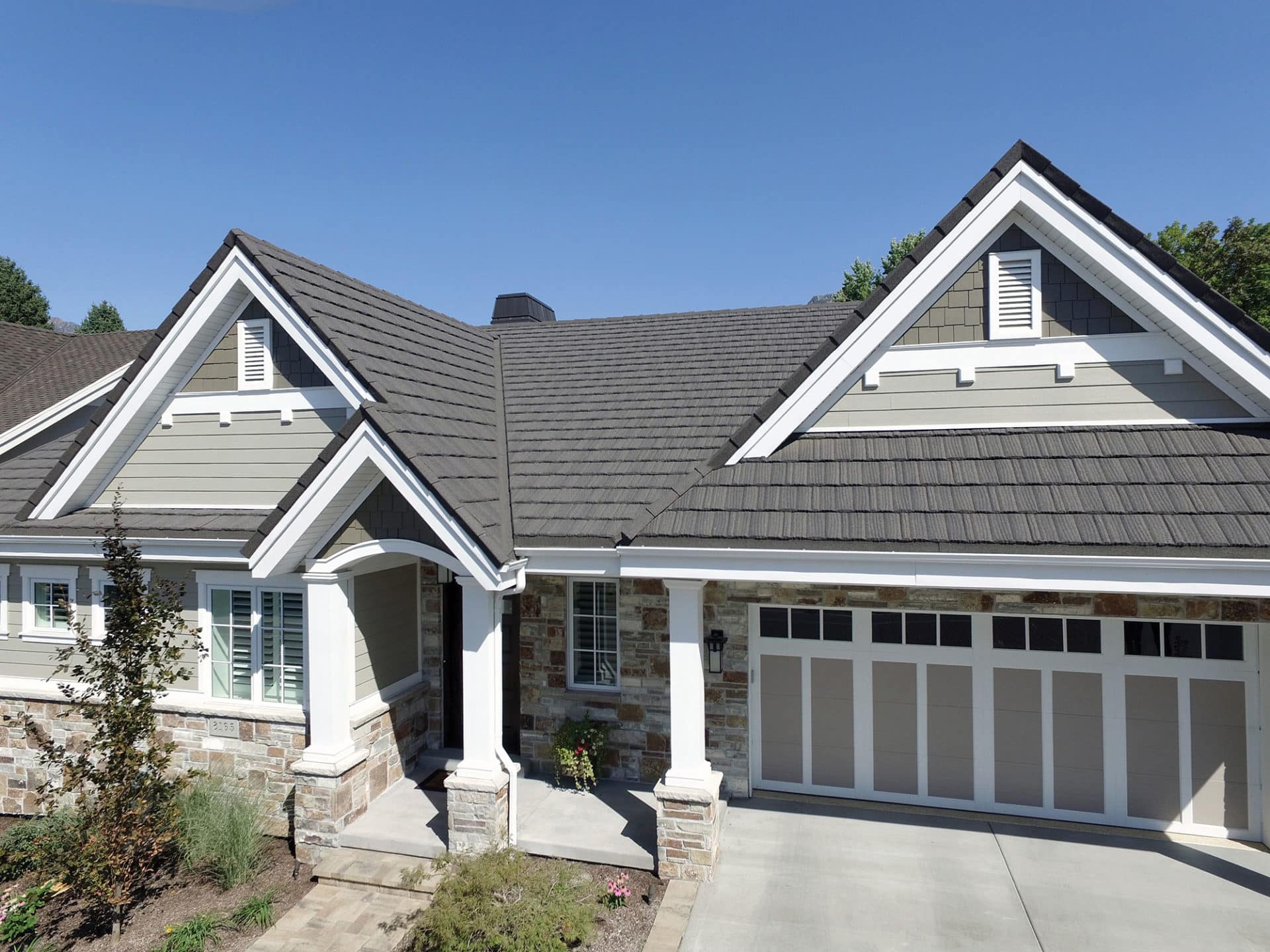
Metal slate roofs — also called stone coated steel roofs — give the appearance of natural slate roof shingles without the heavy weight or the extremely high price tag.
Stone coated metal roofing averages between $5 and $12 per square foot, compared to natural slate that typically costs between $15 to $30 per square foot.
Metal slate roofs have a much nicer appearance than other metal roofing options and look more like a traditional shingle roof, making them a good choice for any style of home.
While stone coated metal is eco-friendly and weather resistant, it doesn’t last as long as other metal roofing options, typically between 30 and 45 years. Still, that’s an improvement from standard asphalt shingles.
Standing Seam Metal Roof
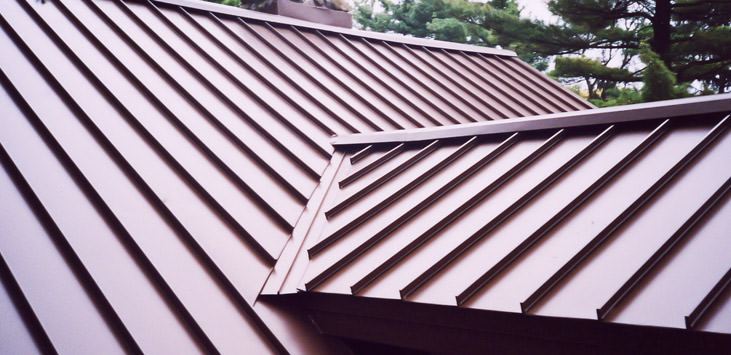
Standing seam is a type of roofing panel that comes in several different metal options, including aluminum, steel, copper and zinc. Depending on which material you choose, standing seam panels can run you between $8 to $14 on average, give or take a dollar on each end.
Standing seam is one of the most popular types of metal roofing materials because it’s widely available and offered by most metal roofing companies. Standing seam roofs have a vertical ribbed appearance, with fasteners concealed underneath the ribs to hold the panels together.
The unique locking system with a standing seam roof allows the panels to expand and contract as temperatures change. Because there aren’t any exposed fasteners, standing seam panels are better protected from weather stresses that can cause leaks and corrosion.
The biggest con with a standing seam roof is it’s a little expensive compared to other metal roofs, but its sleek design and life expectancy of between 30 and 50 years make it a worthwhile investment.
Steel Roofing Prices

As we’ve mentioned, a steel roof can come in many different styles, but for this section, we’re referring to steel shingles and tiles. A steel roof is more resistant to cracking, erosion and shrinking compared to other metals, expected to last between 40 and 70 years.
Steel roofing typically ranges from $3 to $12 per square foot, but it depends on the type of steel. For example, galvanized steel is coated with zinc for increased durability, while galvalume steel includes a mix of aluminum, zinc and a small amount of silicon. Both are relatively affordable options, ranging from $3 to $4.25 per square foot.
On the other hand, stainless steel roofing can come in as high as $10 to $16 per square foot. Stainless steel holds up best against the elements, but it’s also harder to work with, meaning you’ll probably incur higher labor costs during your installation.
Tin Roof Costs
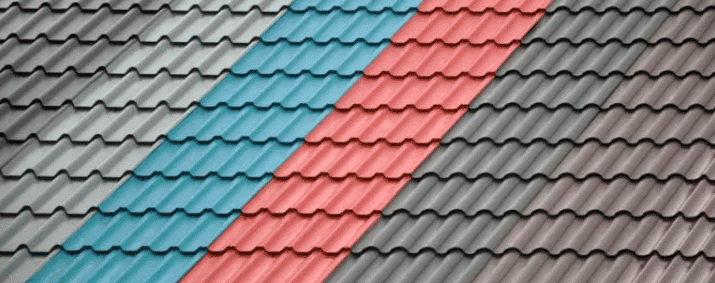
Tin metal roofs are usually made up of a product called terne, which is rolled steel coated with tin alloy. Because they’re plated, tin roofs come in a variety of different colors and are a great middle-of-the-road choice, ranging from $3 to $15 per square foot of material depending on style.
Tin roofs are durable and resistant to cracking and harsh weather conditions, with an estimated lifespan around 40 years. They’re also a great choice for the eco-conscious homeowner, as tin is usually made from 30% to 60% recycled materials.
The downside to tin is that it will develop a gray patina over time due to oxidation, which may diminish the appearance of your tin roof.
Zinc Roof Pricing
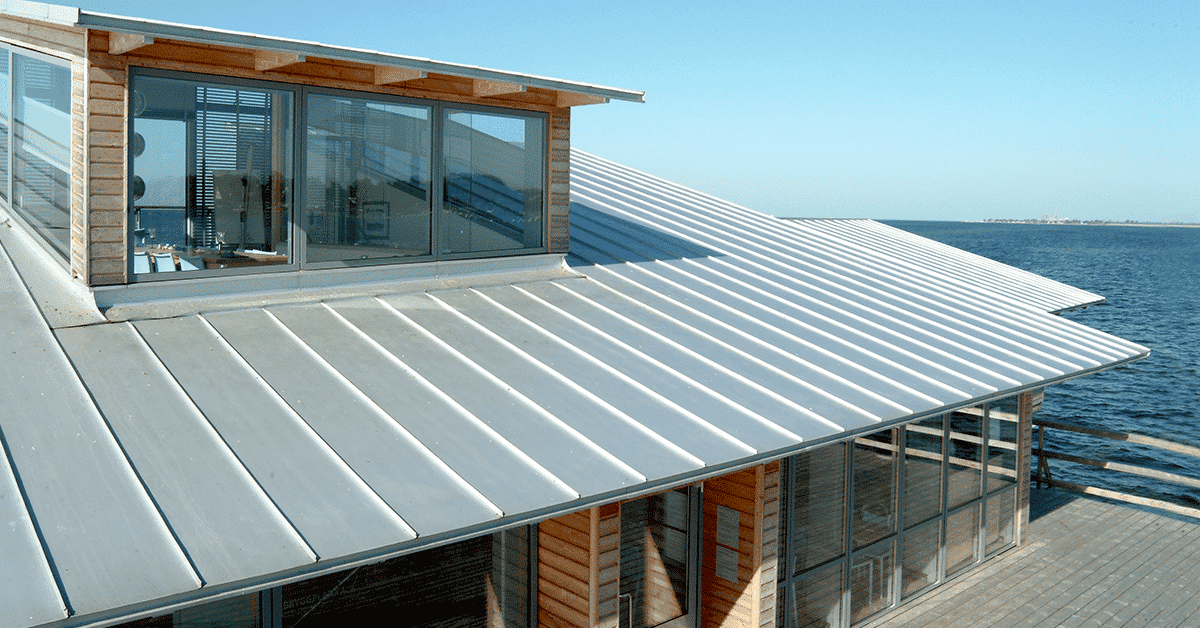
Zinc metal roofs are unique in their folding ability, giving them an attractive look. Zinc is considered a high-quality metal roofing material, which is why it comes with a higher price tag, ranging from $6 to $11 per square foot.
Zinc metal roofs are popular due to their distinct appearance, as well as their ability to hold up against harsh weather conditions. They will last at least 40 years but have been known to last 100 years or longer, making them one of the most durable roofing options in the market.
The recyclability and low toxicity levels of Zinc also make it a very eco-friendly option. It has a low melting point, so it requires less energy to manufacture compared to other metals as well.
Zinc’s self-healing coating can cover scratches and scrapes, which contributes to its long, low-maintenance lifespan.
The only downside to zinc is that it can be difficult to install, leading to higher installation costs and roof issues if not installed properly.
Benefits of Metal Roofing
Metal roofs are most commonly installed on industrial or agricultural structures, but more and more homeowners are considering metal for residential roofing projects.
Here are some of the key benefits of metal roofing that can make it worth the extra cost:
Metal Roofs Are Energy Efficient
While metal roofing is more expensive compared to asphalt shingles, you can feel good about saving on cooling costs.
Metal is reflective, so it directs the heat of the sun away from your home rather than absorbing it. Most experts estimate that you can save between 20% and 30% on cooling costs in the summer with a metal roof.
Environmentally Friendly
Energy efficiency isn’t the only environmentally friendly quality of metal roofs. Metal is easily recyclable and reusable and many metal roofs are made from recycled metals.
According to Sheffield Metals, metal roofing is 100% recyclable, meaning that old panels and metal scraps can be reupurposed for use in future metal products, such as appliances, cans or plumbing.
This recyclability applies to the most common metal roofing types: galvanized steel, aluminum, copper, zinc and stainless steel.
Additionally, metal is more durable and longer-lasting compared to other roofing materials, meaning you won’t have to replace your roof as often, which helps to keep roofing materials out of landfills.
Longer Roof Lifespan and Durability
Speaking of longevity and durability, you can expect a longer average lifespan out of a metal roof. Metal roofs last 40 to 75 years on average, with some materials lasting up to 100 years or more. For context, a standard asphalt roof typically lasts 10 to 35 years.
When it comes to durability, some cheaper metal materials can become dented, but they’re still typically harder to damage compared to standard roofing materials.
Each metal roofing material should come with a warranty that will be a good indicator of its longevity and durability, so be sure to ask your roofing contractor about that.
Weather and Fire Resistance
Its durability makes metal roofing a good option for a lot of different climates, holding up well against of hail, high winds and storms. Additionally, metal is fire and smoke-resistant, making it a great option in areas prone to wildfires.
Tax Credits
Your metal roof installation may qualify you for a federal or local tax credit. Certain Energy Star certified metal roofs qualify for a federal tax credit for 10% of the cost of your installation, up to $500.1
Your state or local government may offer additional tax credits or rebates for energy-efficient metal roofing installations or upgrades.
Insurance Rate Reductions
The type of roof you choose can affect your homeowner’s insurance policy — for better or worse. Fortunately, metal roofs are known to lower homeowners’ insurance by up to 25% because they’re less likely to leak or suffer damage from the elements.
Metal Roofs Will Improve Home Resale Value
Not only can metal roofs boost your curb appeal, but long-lasting, durable roofs are something prospective home buyers might pay more for — especially given they won’t have to worry about paying for roof replacement any time soon.
The Remodeling Report for 2019 found that a metal roof can increase home value by more than 60%.2
Metal Roof Maintenance
Metal roofs need less maintenance compared to many other roofing materials, but there are still things you’ll need to take care of to extend the life of your roof.
You’ll want to regularly clean your roof of debris. This can typically be done with a hose or pressure washer but stay away from abrasive tools that can scratch your metal roof. If scratches do occur, mineral spirits or touch-up paint can repair them.
In general, you’ll want to leave roof cleaning to professionals.
Metal roofing pieces typically come with a roof coating made from zinc (galvanized) or a mixture of aluminum and zinc (galvalume). Each product varies in thickness but you’ll likely still have to recoat your metal roof at some point, no matter which product you choose.
Fortunately, it’s easy to recoat your roof with a polymer coating — like Kynar — to restore your metal roof to its original condition.
Additional Metal Roof Costs And Considerations
Aside from roof material and installation costs, there are a few other considerations that may affect the total cost of your roofing project and maintenance.
Metal Roof Painting or Coating
You can paint a metal roof to better match the aesthetic of your home, although it’s suggested not to paint it until six months after installation., That way, it has time to weather a bit. And as we discussed, metal roof coating can help repair scratches and improve the thickness and durability of the roof.
Painting and coating a metal roof is also known to extend the roof’s lifespan and increase your energy efficiency, so it may be something you want to invest in.
Metal Roof Cleaning
Unless you have experience, we recommend leaving your metal roof cleaning to the professionals. Roofing companies typically charge between $0.20 and $0.70 per square foot to clean a metal roof and do so with a high-pressure washer.
Cost to Remove a Metal Roof
The good news about a metal roof is that it can be installed right on top of most existing roofs. This can save you a lot of money in tear down costs. But if you need to have your roof deck or underlayment replaced or your shingles taken off, that’s going to be an extra charge from your roofer.
Roof removals can add between $1,500 and $3,000 to your total metal roof installation cost.
Is Installing a Metal Roof Worth It?
While metal roofs are almost always more expensive compared to asphalt roofs, they’re definitely worth the investment. Metal roofs are more durable and weather resistant, known to last up to three times longer than an asphalt roof.
The longevity of your roof can save you thousands in the long run by avoiding reroofing or roof replacement costs.
Metal roofs are also far more sustainable than most roofing materials, as they are easily recyclable and often made from recycled materials.
Homeowners will also find they save on energy costs with metal roofs because metal is more energy-efficient and a great insulator.
Finding the Right Metal Roofing Contractor to Install Metal Roofs
You may be asking yourself if you can DIY a metal roof installation but we recommend you think about that again. Metal roofs can be a trickier roofing material to install, making it a job for professional and reputable roofing companies — you should never try to perform a DIY metal roof installation without experience.
To find the best metal roofing company, you’ll first want to get a clear idea of which type of metal roofing you’ll want for your home. From there, you can meet with different roofing contractors who can provide you with estimates and help guide you through the decision process.
It’s best to find a company with a local office so you are able to meet in-person if need be. We also recommend finding a company that not only offers a lengthy material warranty, but also a workmanship warranty that protects you against a poor installation.
Lastly, ask for referrals from former customers who have worked with this company so you can verify that people have had a good experience with their metal roof installation.
Click here to read our picks for best roofing companies
How to Make An Informed Roofing Choice
The EcoWatch team spoke with Todd Miller, a roofing and HVAC expert that has been in the first for over 35 years. Here’s what he had to say about eco-friendly roofing materials.

Can a roof impact the energy efficiency of your home? Is this something that homeowners are considering when choosing a roof?
I think that homeowners are increasingly starting to think about how their roof impacts their home’s energy efficiency. They’re looking at that not only from an operational cost standpoint but from doing the right thing for the environment as well.
And another thing is that oftentimes, a roof is really great real estate to put solar on up on a home. It usually doesn’t have as much obstruction and shadowing to it, and it’s often well-angled for the sun. So, roofs are increasingly thought of as being a great place to locate solar panels or a solar array.
How do you recommend homeowners go about selecting a roofing material?
My advice really is to start out by setting your criteria– what it is you want to accomplish with your next roof. Once you set those criteria, you can use that to help you go out and use the internet or other resources to find a product that meets those needs.
My general advice is a little different than most roofing contractors are going to tell you. My advice is to find a product that first your needs and is right for you and your home. Then contact the manufacturer of that product to find someone in your area who has been trained or is in some way qualified to install that product.
Otherwise, if you go the normal route of just choosing a roofing contractor, you’re probably going to end up with a product that they want you to have, not necessarily the product you want to have on your house.
And frankly, the product that they want you to have probably is going to be the product that they’re the most familiar with, or in a lot of cases, the product they feel they can be most profitable on.
Other than color and style, what are some of these criteria that homeowners look for when deciding on a roofing material?
Because the roof is such a significant portion of a home’s exterior, homeowners are obviously going to care about life expectancy.
Chances are, if they are reroofing their house, they know how long that roof lasted. They may want to do better than that, and we certainly hope that they’re going to be interested in the carbon footprint of the roofing material that they are choosing.
Energy efficiency is another big thing. As you know, energy efficiency impacts the cost to operate the home. But, of course, it’s also an environmental choice.
I think that based on the climate they live in, homeowners are going to think about any severe weather considerations. Homeowners in Florida are going to be thinking a lot about wind resistance, homeowners in California are probably going to be thinking a lot about fire resistance, and homeowners in Texas and Oklahoma are probably going to be thinking a lot about resilience and hail.
What should homeowners know about the lifecycle of different roofing materials?
Another thing we’re seeing a lot is homeowners looking at the total product lifecycle. Folks are saying, Okay, what’s going to happen to this roof when it wears out? Is it recyclable? Some roofing materials are and some are not.
Another thing homeowners are asking is, I’ve got a roof up there right now, does that have to go into a landfill? Or would there be potential to install a new roof over my existing roof?
That being said, what roofing materials are made with recycled content?
There are some asphalt shingles out there that have recycled content, but about 15% is the highest I have ever seen.
Then there are polymer plastic roofing materials. Some of their manufacturers say they have some recycled content, but I’ve never seen any actual figures on that.
Steel roofing typically has at least 35% recycled content, and some steel mills are as high s 85% recycled content.
Aluminum, which is a highly recycled metal almost always has around 95% recycled content when it’s used as roofing.
Copper, which is a fairly high-end roofing material typically has around 35% recycled content.
What can you tell us about roofing materials that end up in landfill?
About 12 million tons of asphalt shingles go into landfills every year. Scientists estimate that asphalt shingles take about 300 to 400 years in a landfill before they will fully decompose.
And at the same time, asphalt shingles have a lot of oil content. So they are releasing that oil into the landfill as well.
However, Building codes in most areas of the country allow up to two layers of roofing. So if someone does just have one layer of roofing on their home right now, they can go over that with another layer, which could be asphalt shingles.
But a lot of times they will also choose a lower-weight roofing material, such as steel or aluminum to go over those existing shingles.
FAQ: Metal Roof Cost
It depends on the material, but metal roofs are estimated to last an average of 40 to 75 years, with some materials lasting 100 years or more. Metal roofs can last two to three times longer than asphalt shingles.
Yes, metal roofs are energy-efficient because metal reflects the sun’s UV rays, directing that heat away from your home rather than absorbing it.
Experts estimate that homeowners with metal roofs save between 20% and 30% on cooling costs in the summer compared to those with standard asphalt roofs.
On average, asphalt shingles are cheaper than metal roofing, but it depends on the material. For example, a higher-quality asphalt composite shingle may cost between $5 and $6 per square foot while a cheaper metal like aluminum can cost $3 per square foot.
Many homeowners are concerned that metal roofs will be loud when it rains because they’re picturing thin aluminum barn roofs or tin awnings that are extremely loud in the rain.
However, that isn’t the case with a metal roof on a home. Metal roofs are installed with insulating underlayments below them, so they’re typically no louder than an asphalt roof when it’s raining.
More Roofing Guides
- The Top 5 Best Roofing Companies (2023 Review)
- 4 Best Gutter Guards for Metal Roofs (2023 Guide)
- Metal Roof Vs. Shingles: Differences and Cost Analysis (2023)
- How Much Does it Cost to Paint a Metal Roof (2023)
- Slate Roof: Usefulness, Costs & Installation Information (2023 Guide)
- Rolled Roofing: Usefulness, Costs & Installation (2023 Guide)

 233k
233k  41k
41k  Subscribe
Subscribe 



